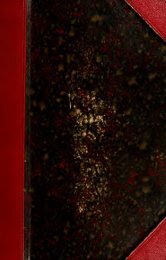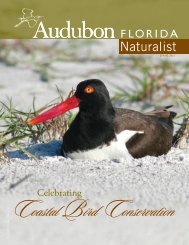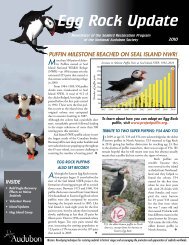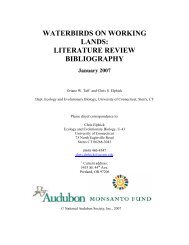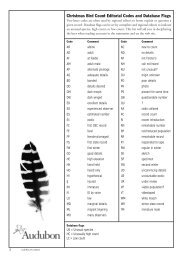Full report [PDF] - the Boreal Songbird Initiative
Full report [PDF] - the Boreal Songbird Initiative
Full report [PDF] - the Boreal Songbird Initiative
Create successful ePaper yourself
Turn your PDF publications into a flip-book with our unique Google optimized e-Paper software.
Table 3. Species with 25–49 percent of estimated Western Hemisphere breedingpopulation in North America’s <strong>Boreal</strong> Forest Region (55 species).Greater White-fronted GooseCanada GooseNor<strong>the</strong>rn ShovelerNor<strong>the</strong>rn PintailCommon EiderLong-tailed DuckRed-breasted MerganserDouble-crested CormorantAmerican BitternOspreySharp-shinned HawkNor<strong>the</strong>rn GoshawkBroad-winged HawkSandhill CraneAmerican Golden-PloverSemipalmated SandpiperDunlinStilt SandpiperAmerican WoodcockFranklin’s GullBlack TernLong-eared OwlBelted KingfisherHairy WoodpeckerNor<strong>the</strong>rn FlickerWestern Wood-PeweeEastern PhoebeRed-eyed VireoBlack-billed MagpieTree SwallowBank SwallowBlack-capped ChickadeeRed-breasted NuthatchWinter WrenGolden-crowned KingletArctic WarblerVeeryAmerican RobinVaried ThrushAmerican PipitCedar WaxwingYellow WarblerChestnut-sided WarblerAmerican RedstartOvenbirdAmerican Tree SparrowChipping SparrowSavannah SparrowNelson’s Sharp-tailed SparrowSmith’s LongspurRose-breasted GrosbeakPurple FinchCommon RedpollPine SiskinEvening GrosbeakTable 4. Species with more than 80 percent of estimated Western Hemisphere breedingpopulation in North America’s <strong>Boreal</strong> Forest Region (35 species).Surf ScoterBonaparte’s GullBohemian WaxwingWhite-winged ScoterHerring GullTennessee WarblerBlack ScoterGreat Gray OwlCape May WarblerBuffleheadAmerican Three-toedPalm WarblerCommon GoldeneyeWoodpeckerBlackpoll WarblerLesser YellowlegsPhoto © Ducks Unlimited CanadaSpruce GrouseRed-necked GrebeWhooping CraneBlack-backed WoodpeckerYellow-bellied FlycatcherAlder FlycatcherConnecticut WarblerLincoln’s SparrowWhite-throated SparrowLesser YellowlegsNor<strong>the</strong>rn ShrikeDark-eyed JuncoSolitary SandpiperPhiladelphia VireoRusty BlackbirdSurfbirdGray JayPine GrosbeakShort-billed Dowitcher<strong>Boreal</strong> ChickadeeWhite-winged CrossbillMore than 80 percent of <strong>the</strong> populations of 35 species are found in <strong>the</strong> <strong>Boreal</strong>Forest Region (Table 4). This includes a surprising variety of species, including PalmWarbler (> 90 percent of population in <strong>Boreal</strong> Forest Region), Short-billed Dowitcher(> 90 percent of population in <strong>Boreal</strong> Forest Region), Nor<strong>the</strong>rn Shrike, (> 90 percent),Bonaparte’s Gull (> 90 percent), Spruce Grouse (> 90 percent), Red-necked Grebe(> 90 percent), Gray Jay (80–90 percent), Bufflehead (80–90 percent), White-wingedScoter (80–90 percent), Rusty Blackbird (80–90 percent), and Great Gray Owl(80–90 percent). For <strong>the</strong>se species, <strong>the</strong> <strong>Boreal</strong> Forest Region is virtually <strong>the</strong>ir onlystronghold on earth.How important is North America’s <strong>Boreal</strong> Forest Regionfor birds during spring and fall migration?Virtually all species of boreal nesting birds also make use of parts of <strong>the</strong> <strong>Boreal</strong>Forest Region during migration. Some birds rely more on <strong>the</strong> <strong>Boreal</strong> Forest Regionfor migratory stopover habitat than for breeding or wintering. These 29 bird species(Table 5) include some that do not breed anywhere in <strong>the</strong> <strong>Boreal</strong> Forest Region. For34 AMERICAN BIRDS


![Full report [PDF] - the Boreal Songbird Initiative](https://img.yumpu.com/52893853/7/500x640/full-report-pdf-the-boreal-songbird-initiative.jpg)


